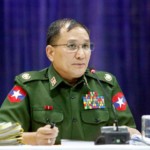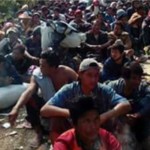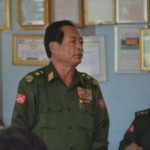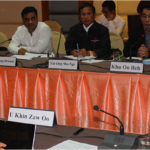By Pangmu Shayi / Kachinland News | July 20, 2016
The hype surrounding the upcoming national conference invoking the name “Panglong”, gives cause to hark back on the “first” Panglong Conference, and reflect on its place in the national psyche and the deep emotions it conjures up then and now.
The Panglong Conference of 1947 brought together Bamar, Shan, Kachin and Chin leaders from discrete administrative areas under British Burma – specifically “Burma Proper”, or Bamar dominated Lower Burma, and the Frontier Administration Areas, homeland to the Shan, Kachin and Chin – to discuss the whys and wherefores of forging an alliance to expedite freedom from British colonial rule. The agreement reached paved the way for Burma’s independence the next year, and the creation of the geographical composition we know of today as The Union of Burma or Myanmar.
In the lead up to the conference, the charismatic Bamar leader General Aung San had come up to Kachin and Shan lands and given impassioned pleas to rally behind the independence movement. His promise of equal rights symbolized by the slogan “Bamar One Kyat – Shan/Kachin One Kyat” resonated with the frontier peoples, but forming a union with the lowland Bamars was by no means a foregone conclusion.
The Chins, from the very outset, were in favor of union with lowland Burma, but more out of economic necessity than anything else. Opinion among the Shan and Kachin delegates was divided prior to Panglong. The Kachins from the Myitkyina region were the only ones who had signed on to the idea of independence. The Bhamo region delegates and Shan leaders were in favor of the British promise of “home rule” as an alternative to outright independence. It is to be noted that the Myitkyina region is home to the “Hkahku” or upriver Kachins who had put up stiff resistance to the British incursion, taking the British more than 40 years to pacify the region. Also, there were many elders and chieftains with long memories who recalled how Sir Harcourt Butler, the then British governor, rudely rebuffed their petition for home rule in 1925.
The paper prepared by Myitkyina delegates advocating autonomy in the administration of ethnic areas, as well as the creation of a new Kachin State after independence, generated intense discussion among the Kachin and Shan representatives, and finally swayed opinion to the idea of independence.
Even so, misgivings about union with the lowland Bamars, and apprehensions of Bamar hegemony lingered. It took all the assurances that General Aung San could give as head of the interim Burmese government, to convince the non-Bamar leaders to put their trust in forming a union with the Bamars. Gen Aung San, in response to Shan and Kachin expressions of mistrust of Bamar leaders other than himself, cautioned them not to put their trust in personalities but in the constitution they would be drafting together. He invited them to take part in the Constituent Assembly where matters such as the right to secession and other safeguards they wish included in the Constitution would be fully addressed. And so at Panglong, Kachin and Shan leaders negotiated terms whereby they received guarantees which included “full autonomy in internal administration for the Frontier Areas”, and the creation of a new Kachin State in return for agreeing to join hands with the Bamars in forming the Union of Burma.
After independence however, the non-Bamar signatories found themselves feeling shortchanged on the promises of Panglong. Instead of enjoying the autonomy they had envisioned under a federated system of government, they found themselves chafing under the tight control of a centralized government dominated by ethnic Bamars. The agreement their forefathers put so much effort to bring to fruition, was no longer honored, and the much acclaimed Panglong or Union Spirit, but an illusion.
The late Kachin historian Rev. Dr. Maran Ja Gun offered the view that the Nu-Attlee Agreement, the independence agreement signed between Prime Minister U Nu and the British Premier Clement Attlee in October 1947, did a great disservice to the ethnic minority cause. The agreement made with sole Bamar representation (non-Bamar leaders not yet politically sophisticated to demand inclusion) allowed for the transfer of all properties and administrative power to U Nu’s AFPFL (Anti-Fascist People’s Freedom League) government, giving it control of parliament and ethnic affairs.
From the Kachin perspective, it allowed for U Nu and his government to meddle in Kachin affairs, such as allocation of budget and development projects, and even in the forming of State government and appointment of State chief administrator. The simmering discontent boiled over into public protests when in 1960, three Kachin villages were ceded to China over strong Kachin opposition. Added to this was the declaration of Buddhism as state religion, which the Kachins interpreted as an affront to their non-Buddhist majority status while also being unconstitutional.
The disenchantment with the established system led Kachins to choose the path of armed insurrection to regain guaranteed rights. A group of university students established the Kachin Independence Organization in 1960, then the Kachin Independence Army (KIA) in 1961, and ever since, despite intermittent attempts at negotiating peace, including a 17-year period of ceasefire, the flames of civil war remain unquenched in the Kachin area.
Almost 6 decades of military rule in one form or another has seen the devastation of Kachin lands through unbridled resource exploitation, and the subjugation of Kachin people to untold abuse and persecution. The renewed war of 2011, especially, has seen hundreds of thousands of Kachins internally displaced, living in deplorable conditions at borderland camps. The war has entered its 6th year, but the Tatmadaw or Burma Army, is showing no signs of letting up, but is instead intensifying its assault with renewed vengeance.
And now, the General’s daughter, the State Counselor Daw Aung San Suu Kyi, has called for a new Panglong, a national conference to be held in August to address the country’s “21st Century concerns”, with emphasis on peace building and national reconciliation.
On the surface, it sounds like a second chance for non-Bamar signatories to make their Panglong dream come true, and for the daughter of Aung San to realize the promises her father made to ethnic minorities at Panglong. But the reality is the 2008 constitution, which in essence is a denial of ethnic minority aspirations for a democratic federal form of government. Also, the eerie silence with which the newly elected NLD government (which won with the support of a majority of ethnic votes) has reacted to the army’s continued onslaught on ethnic lands, is not much of a confidence builder. Such a scenario does not auger well for hopes of a significant breakthrough in the proposed “Second Panglong”.
Daw Aung San Suu Kyi’s desire to fulfil her late father’s commitment to the ethnic minorities at Panglong is no doubt sincere, but in the words of her famous father, ethnic stakeholders should not put their trust in personalities. And as to his admonition of putting their trust in the constitution, history has shown that even the constitution they had a hand in drawing up is no guarantee of safeguarding their rights, where the army is concerned.
When all is said and done, it is ultimately the Tatmadaw, which holds the key to national peace and reconciliation. Unless and until it withdraws from the national political arena, and from ethnic lands, and allows the current constitution to be amended, chanting the Panglong mantra as an invocation to ethnic unity will be a futile exercise.
This article originally appeared on Kachinland News on July 16, 2016.







